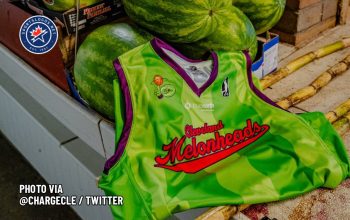
Whatever the theme, the NCAA embraces city identity in crafting a new mark and brand identity for the Final Four each and every year. For 2019, it’s angularity in the NCAA’s celebration of nature in the Final Four logo. For 2020, look for the rising of the Phoenix to provide an overall upward motion.
“We want to create a unique experience year to year,” says Nathan Arkins, NCAA assistant director of championships and alliances. “Minneapolis is very urban and trendsetting in moving forward and we see that tied in with the water, as well as the nature within the trees.”

Ever since the NCAA rebranded in 2016, they’ve had a fresh approach to logo architecture, one that frees them up to explore color, font and unique creations each year.
For 2019, the NCAA worked with the local organizing committee to determine some of the critical points of interest that the NCAA then partnered with Indianapolis-based firm Section 127 to incorporate into the Minneapolis design, an 18-month process that releases more than a year before the event.
But before the NCAA got to the final design, Arkins worked with Section 127 to present four completely different ideas to the NCAA. “Those in the room try to narrow it down to two and we might have a tweak here and there, whether a font, different architecture pieces of even coloring,” he says. “There were some (ideas) presented for Minneapolis that might have been similar to Phoenix or San Antonio and we try to bring in other colors to complement the city and overall mark.”

The final design — which was a fairly unanimous choice among all the initial ideas — brings the 2019 event to a new place in design, focusing on four shades of blue and multiple shades of green while embracing both nature and the angularity found in U.S. Bank Stadium, the home of the tournament. The coloring system provides something new for the NCAA versus past designs.
With the final design settled, Arkins and Section 127 then work from the inside out, focusing on the tickets, court design and big hits on the exterior of the stadium to define the overall brand. From there, they move to other places in the stadium and city to create branding material. This year, the heavy use of blues and greens allowed for the orange in the logo to spill into a larger role inside the venue to brighten up the colors.

The focus of nature in the design offers a fresh approach for the NCAA. “The nature aspect of it, that is a path we have not been down before,” Arkins says. “We have brought that element in.” And they did with U.S. Bank Stadium-themed angularity, whether in the Final Four font, the trees, the overall architecture of the logo or across the bottom in the differing shades of blue. As part of the new branding, you’ll find reference to championship banners or a trophy in every NCAA logo. The blue across the bottom of the logo not only allows designers to embrace the land of lakes and the Mississippi River as part of the nature theme, but also gives a chance to present angular championship banner. The four stars in the nature-filled skyline represent the four teams playing in the Final Four.
For 2020, instead of banners, the upward-focused Atlanta 2020 mark — a completely different architecture from 2019 that plays up red, orange and blue in different ways — offers a basketball trophy design in the middle of the mark.
The colors of 2019, though, come completely different for Final Four marks. While the PMS 300 of the NCAA blue disc logo will always live somewhere in the logo, that doesn’t mean designers can’t play with other shades of blue. It just means that when they do, they must complement that shade, not straying too far from it. “Colors need to work off each other and we compare year to year so we don’t have similar colors,” Arkins says. “We reference what we have done so we don’t have similar marks.”
The main Legacy font can vary from year to year too. In 2019, expect the angularity of the stadium lines to punctuate the “F” of each of the two words. The customization of Legacy in 2020, though, gets a more “upright” look to mimic the aesthetic of that design.

When Arkins looks back to the cutting room floor for the 2019 design, he doesn’t see anything he wishes made it into the final design. “When Section 127 unveiled the look to the national office this was the look that everyone in the room tended toward,” he says.
For 2019, the NCAA has embraced cool-coloured angularity and nature. For 2020, it’s the upward rising or a Phoenix or hoisting of a trophy. But no matter the individual logo architecture, colour choices or themes, know that each Final Four mark has a singular identity meant to represent the nature of the city.
NCAA Men’s Final Four Logo History: 1979-2020
Studio Stories is a monthly column from Tim Newcomb that explores the stories behind some of the designs dominating the sports landscape. Follow Tim on Twitter at @tdnewcomb.











